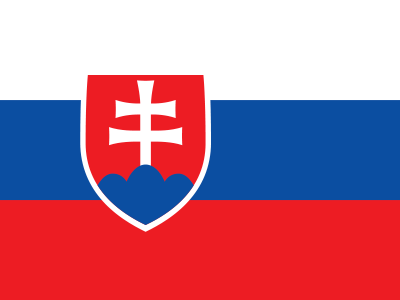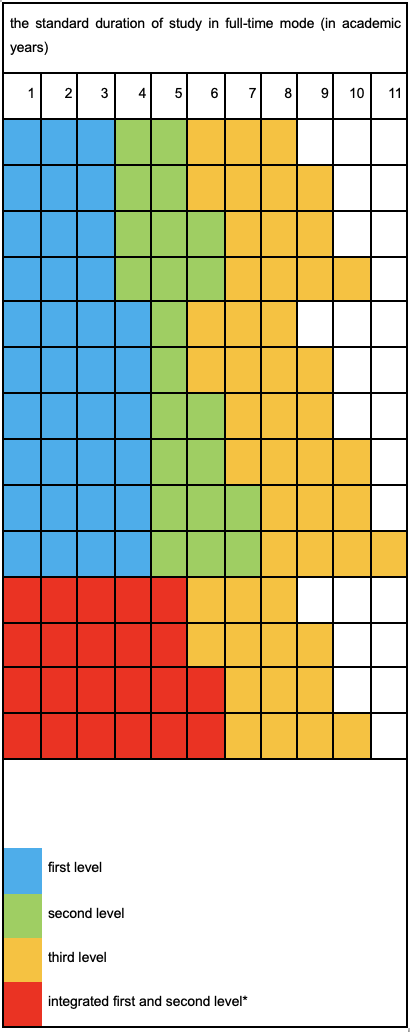
Slovakia
Last updated in January 2024
Chapter 1: Higher Education System
Section 1.1.: Schematic Description of the Higher Education System

minimálny počet rokov štúdia/minimum number of years of study
Section 1.2: Description of Higher Education System
Higher education system in Slovakia follows the principles of Bologna Declaration.
Higher education institutions in Slovakia provide study programs at three levels:
- The Bachelor’s study program which takes three years at least and four years at most (in the case of architecture, fine art and design).
- The Masters study program (the “Magisters”, “Engineering” and “Doctor’s” study program). The study takes one year at least and three years at most, so that the total standard duration of study according to the bachelor study program and the subsequent master level study program in the same or related field of study is altogether a minimum of five years. The basic condition for admission to the second level study is graduation from bachelor study.
- The PhD study program. The standard length in full‑time form is three years at least and four years at most, duration in part‑time form and at some faculties of medicine with a specialization examination is five years. The basic condition for the admission to the PhD study program is graduation from second level university study.
All study programs must be accredited.
The study at the higher education institutions in the Slovak Republic is governed by the Act on higher education. Higher education institutions can enrol students only to the accredited study programs that are pursued on the basis of the credit system.
Every citizen, including foreign nationals, has the right to study at a higher education institution in the elected study program, provided he or she meets the basic admission conditions under § 56, and other conditions as laid down by the higher education institution offering the relevant study program, under Section 57 paragraph 1.
Based on founding and funding there are 3 types of HEIs:
- Public Higher Education Institutions are established by law. They are funded by the government. They are statutory and self-governing institutions. At present, there are 20 public HEIs in Slovakia
- State Higher Education Institutions (3 HEIs) are military, police and medical schools. They are established by law and governed by the state through the respective ministries of the government. The state HEIs are fully funded from the state budget.
- Private Higher Education Institutions (10 HEIs) need state approval issued by the Government of the Slovak Republic. Most of the private HEIs provide education in the fields of economics, business, management, public administration, law, international relations, regional development, medical and social work.
Section 1.3: Number of Higher Education Institutions
https://www.minedu.sk/vysoke-skoly-v-slovenskej-republike/
Section 1.4 Number of Students in Higher Education
https://www.minedu.sk/vyrocne-spravy-o-stave-vysokeho-skolstva/
- General number of students p 5
- Number of students divided by type of institution (if available) p 5
- Number of foreign students enrolled in full degree programmes (if available) p 5
- Number of outgoing exchange students with credit transfer (if available) p 15
- Number of incoming exchange students with credit transfer (if available) p 16
Section 1.5: Structure of Academic Year
Section 1.6: National Qualifications Framework (or Similar)
The National Qualifications Framework of the Slovak Republic is based on 8 qualifications levels, which is a structure approved by the ministry of education.
At the end of 2017, the Ministry of Education, Science, Research and Sport of the Slovak Republic announced the finalisation of the process of introducing Slovak Qualifications Framework level to certificates of education. Including Slovak Qualifications Framework/European Qualifications Framework level on certificates of education was implemented by updating new forms and amending the respective decrees (SK).
National_qualifications_framework_Slovakia_final.pdf (asemlllhub.org)
Slovakia | CEDEFOP (europa.eu)
Section 1.7: Learning Outcomes in Higher Education
Section 1.8: Admission Requirements to Higher Education
The study at the higher education institutions in the Slovak Republic is governed by the Act on higher education. Higher education institutions can enrol students only to the accredited study programs.
Every citizen, including foreign nationals, has the right to study at a higher education institution in the elected study program, provided he or she meets the basic admission conditions under § 56, and other conditions as laid down by the higher education institution offering the relevant study program, under § 57.
Each applicant for bachelor study programme must accomplish complete secondary education (finished by maturita). Each HEI could set up other criteria to enroll students.
Section 1.9: Grading System
For the assessment of students’ achievements, the credit system following the rules of the European Credit Transfer and Accumulation System (ECTS) is used; it was introduced in 2002 for all levels and forms of higher education studies. Student’s standard workload is expressed by the number of credits: 60 credits per academic year, 30 credits per semester and 20 credits per trimester. Every HEI determines the total number of credits required for the due completion of the study in its respective stages.
Grading system works as follows:
Mark A means excellent (grade 1)
Mark B means very good (grade 1,5)
Mark C means average (grade 2,0)
Mark D means satisfactory (grade 2,5)
Mark E means sufficient, so student met the minimum criteria (grade 3,0)
Mark F or FX means failure (grade 4,0)
Section 1.10: Tuition Fee System for International Students
Tuition fees for study programmes offered in foreign languages are set by each HEI/faculty separately. Fees vary between HEI and faculties. Updated information on tuition fees can be obtained from international relations offices of the respective HEIs/faculties.HEI could decide if international students shall pay fees or not.
However, students studying full-time in Slovakia without exceeding the standard length of study do not pay tuition fees, if they study a programme offered in the Slovak language (more information about study programmes offered in the Slovak language can be found at https://www.portalvs.sk/en/– in Slovak language only).
Tuition fees and study-related fees for students studying under international agreements shall comply with the provisions of these agreements. The provisions do not apply to international students with permanent residence in the territory of the Slovak Republic.
Section 1.11: Graduation Requirements and/or Qualification Awarding Requirements
In accordance with the level of study, HEIs award the following academic degrees:
1st level – Bachelor (comprising app. 180 – 240 ECTS credits):
“bakalár” (abbr. “Bc.”)
2nd level – Master (comprising app. 60 – 120 credits):
“magister” (abbr. “Mgr.”)
“magister umenia” in the field of art (abbr. “Mgr. art.”)
“magister architektúry” in the field of architecture (Mgr.arch.)
“inžinier” in technical, agricultural and economic fields of engineer’s programmes (abbr. “Ing.”)
“inžinier architekt” the academic degree in the field of architecture and town planning (abbr. “Ing. arch.”)
“doktor všeobecného lekárstva” in the field of human medicine (abbr. “MUDr.”)
“doktor zubného lekárstva” in the field of dentistry (abbr. “MDDr.”)
“doktor veterinárskeho lekárstva” in the field of veterinary medicine (abbr. “MVDr.”)
3rd level – PhD (doctoral level 180 – 240 ECTS)
“philosophiae doctor” (abbr. “PhD.”),
“artis doctor” in the field of art (abbr. “ArtD.”)
Section 1.12: Relevant Current and Prospective Reforms in Higher Education
Short cycle and Micro-credentials
Performance based funding in HE
Support of internationalization of HEI
Changes in funding scheme
Support of social dimension
Chapter 2: Quality Assurance in Higher Education
Section 2.1: Quality Assurance Body in Higher Education
The mission of the Agency is to contribute to improving the quality of higher education through modern tools following the European Standards for Quality Assurance in Higher Education (ESG 2015). The Agency is intended to provide a mirror of quality to higher education institutions and to decide on the granting of appropriate accreditations following the law. The Agency replaces the activities of the Accreditation Commission, an advisory body of the Government of the Slovak Republic in assessing applications of higher education institutions, and also takes over the decision-making authority of the Minister of Education, Science, Research and Sports of the Slovak Republic.
Section 2.2: Quality Assurance System
| Study programme | Institution | Further explanation | |
| Voluntary
Please tick. |
|||
| Compulsory
Please tick. |
X | X | |
| Regularity (years)
Please indicate the number of years |
X | Once in 6 years | |
| External
Please tick. |
x | By Slovak Accreditation agency for higher education | |
| Internal
Please tick. |
X | After finishing institutional validation by Slovak Accreditation agency for higher education | |
| Further information: Slovak QA system moved from single study programme accreditation to institutional accreidtation. The agency decides in study fields the HEI is compliant with accreditation standards. In such study fields the HEI could accredit its study programmes without further application on agency. If the HEI wants to accredit new study programme in study field in which it has no study programmes, it has to apply to agency to do the accreditation process.
|
|||
Section 2.3: Link Programme Authorisation with Quality Assurance
All programmes need to by accreditated. After institutional accreditation the HEI could create its study programmes without agency permission, but the agency shall provide regular check/supervision on new study programmes. New study programmes are accredited by the agency only in study fields in which the HEI does not have any programme.
All study programmes must be aligned to the new accreditation standards and covered by the internal QA system.
Study programmes register: https://www.portalvs.sk/en/morho
Chapter 3: Credit System in Higher Education
Section 3.1: Description of Credit System
For the assessment of students’ achievements, the credit system following the rules of the European Credit Transfer and Accumulation System (ECTS) is used; it was introduced in 2002 for all levels and forms of higher education studies.
Section 62 of the Act on higher education
131/2002 Z.z. – Zákon o vysokých školách a o zmene … – SLOV-LEX
Section 3.2: Credit Transfer System(s)
- AUN – ACTS: the AUN ASEAN Credit Transfer System
- UMAP – UCTS: the University Mobility in Asia and the Pacific Credit Transfer Scheme
- SEAMEO RIHED ACTFA: the SEAMEO – RIHED Academic Credit Transfer Framework for Asia
- ECTS – European Credit Transfer and Accumulation System
Section 3.3: Application of Credit System in Higher Education Institutions Obligatory?
Section 3.4: Number of Credits per Academic Year/Semester
60 credits per academic year, 30 credits per semester and 20 credits per trimester
Section 3.5: Number of Credits per Higher Education Cycle
1st level – Bachelor (comprising app. 180 credits)
2nd level – Master (comprising app. 120 credits)
3rd level – PhD. 180 -240 ECTS
Section 3.6: Description of Credit Unit
Section 3.7: Link between Learning Outcomes and Credits